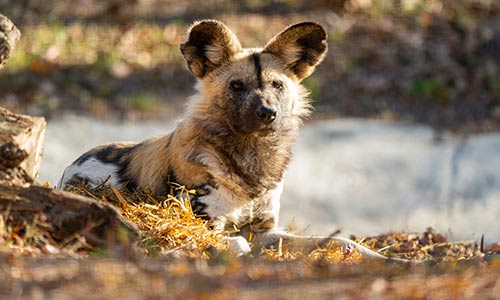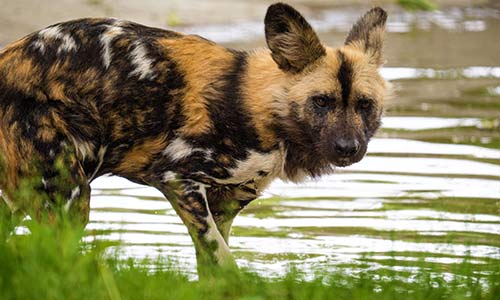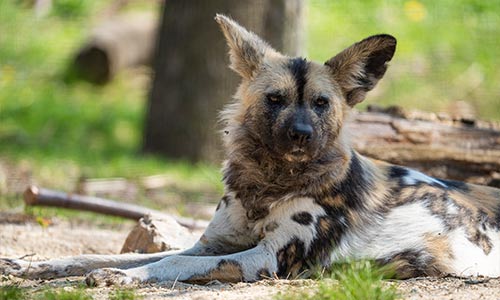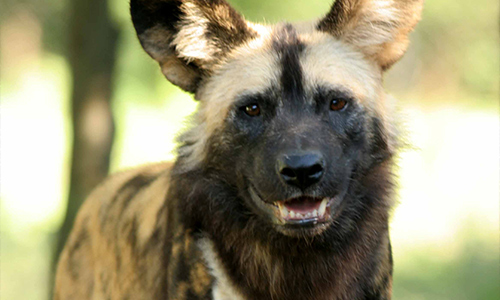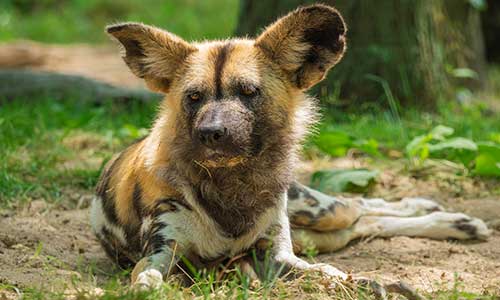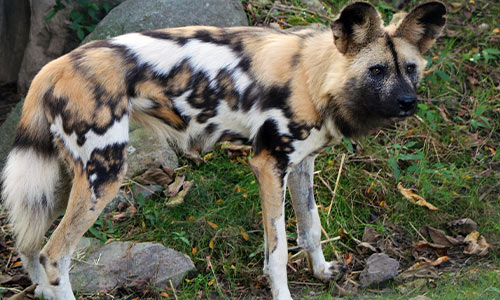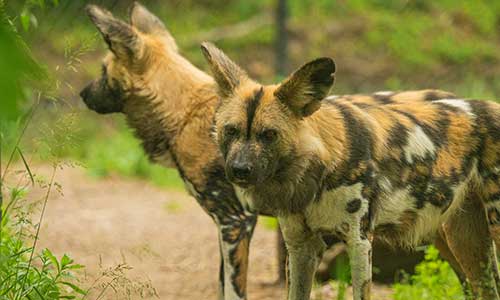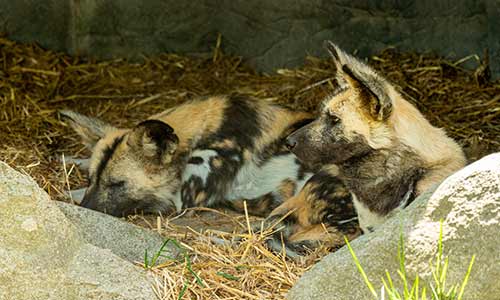African Painted Dog
Lycaon pictus
Meet painted dog sisters Moremi and Madikwe in their habitat by the Zoo's Giraffe entrance.
About the African Painted Dog
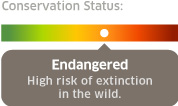
Geographic Range:
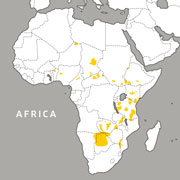
Class: Mammalia
Order: Carnivora
Family: Canidae
Genus: Lycaon
Species: pictus
African painted dogs are part of the Canidae family, along with wolves and coyotes. They have large, rounded ears, which give them excellent hearing and help keep them cool, and their long legs help with speed and endurance. Painted dogs earn their name from their unique patchwork splotches of color. Their mottled brown, black and white coloring is unique to each individual, like a human fingerprint. The painted dog pack is a close-knit family group. They care for pups, play and hunt together as a team.
Committed to Conservation
Zoo New England supports Lion Landscapes in their multi-year survey initiative to assess the status and conservation needs of Tanzania's painted dogs in an effort to bolster their population.
Zoo New England participates in the African painted dog Species Survival Plan. By sharing research and knowledge, participating institutions work together to establish guidelines that best ensure the health of captive populations, and with success, the survival of endangered species.
SAFE: Saving Animals From Extinction
We're proud to support the Association of Zoos and Aquariums' SAFE initiative. This program brings together the expertise and resources of AZA-accredited zoos, aquariums, and conservation organizations to protect endangered species and their habitats.
You Can Help!
Painted dogs are susceptible to diseases like rabies and canine distemper, which can also be spread to other wildlife. Much of this spread is exacerbated by unvaccinated domestic dog populations. The health of wildlife can affect the health of people too. We’re all connected and depend on each other to stay healthy. Do your part for conservation by making sure your pets are up to date on their vaccinations. Preventing the spread of disease among wildlife both here and afar will protect humans and other animals from existing or new diseases.
The Association of Zoos and Aquariums' "Reduce the Risk" initiative aims to reduce zoonotic disease threats by combating wildlife trade that poses a risk to human and animal health. Through its Government Affairs and Wildlife Trafficking Alliance programs, AZA has committed to combating illegal wildlife trade, in addition to addressing unsustainable trade in wildlife.
African Painted Dog Facts
Appearance:
African painted dogs are part of the Canidae family, along with wolves and coyotes. They have large, rounded ears, which give them excellent hearing and help keep them cool, and their long legs help with speed and endurance. Painted dogs earn their name from their unique patchwork splotches of color. Their mottled brown, black and white coloring is unique to each individual, like a human fingerprint. As a pack of dogs hunts together, this camouflage coloring helps confuse their prey.
Painted dogs have a unique dental characteristic that distinguishes them from other canids: all of their teeth are sharp and designed for shearing, as opposed to being sharp and flattened like those of other canids. This allows dogs to quickly shred a carcass. They’re also the only canids with four instead of five toes on their front paws. They lack a dewclaw (a toe and nail that sits in a similar position to that of a human thumb) on their front feet.
Size:
- Height: 30 inches tall at the shoulder
- Length: 30-40 inches long; with tail, 12 to 16 inches long
- Weight: 40 to 80 pounds
Diet:
Painted dogs are opportunistic, carnivorous predators. Their prey includes medium to large antelope, gazelle, zebras, warthogs, rats and hares. Hunting in a coordinated pack, they can pursue prey over a long distance with a high sustained rate of speed.
Reproduction:
African painted dogs reach sexual maturity at 18 months of age. Though they can breed at any time, they usually have litters between March and June. The pack’s dominant female and male breed, with females producing typically seven to 12 offspring per litter (up to 21 have been recorded). The mother stays with her pups in the den while other pack members hunt and help guard against predators.
Behavior:
The painted dog pack is a close-knit family group. They care for pups, play, and hunt together as a team. Packs are made up of mostly males, with a dominant breeding pair. The average pack size is five to 20 dogs. Females leave the pack at around 3 years of age, whereas males tend to stay with the pack for life.
This species is nomadic and mostly active at dawn and dusk (crepuscular). They’re highly efficient and cooperative hunters. Dogs use a clever relay hunting strategy to exhaust their prey as they take turns running at the front up to 40 miles per hour. This speed, endurance and pack structure make them extremely successful predators. They use a wide range of vocalizations to communicate, including barks, howls, “twittering” and whining. The pack forms social bonds through vocalizations, and unlike other canids, they don’t howl. Instead, they make short, repetitive “hoo” sounds to keep track of one another during a hunt. Dogs also use scent marking throughout their territory.
Habitat/range:
Southern/Sub-Saharan Africa in isolated populations. They can be found in habitat ranging from open grasslands to forested alpine areas.
Threats:
Hunting; killing in retaliation for perceived livestock predation; habitat change/fragmentation; and diseases spread from domestic dogs are all threats to this species.
Median Life Expectancy:
10 – 12 years in the wild
Threats
Painted dogs, also known as African wild dogs or African hunting dogs, face a medley of threats and may be the most endangered carnivore in Africa. Once roaming across most of sub-Saharan Africa outside of the rainforest and desert regions, and numbering perhaps as many as 500,000 animals, there may be as few as 7,000 painted dogs remaining in the wild today.
Listed as Endangered by IUCN, painted dogs are highly social and tend to live at fairly low densities. They also need large areas for home ranges, and as wild habitat shrinks across Africa those remaining areas, including protected areas, tend to be too small to hold sustainable populations of this species. Thus loss of habitat, and fragmentation of those habitats, are probably the single greatest threat to long-term painted dog survival.
Three other threats are also significant. Direct killing of painted dogs by humans often occurs, either accidentally in snares set for other species or purposefully, often by herders to protect livestock (although painted dogs rarely kill livestock, preferring wild prey). Disease is also a significant factor, as rabies and canine distemper can quickly wipe out a local population, and with habitats widely fragmented and separated by high human densities, this may lead to painted dogs disappearing forever from an area. Finally, other large predators, especially lions and hyenas, are a threat, especially in smaller protected areas where the densities of these predators can be quite high. Loss of pups to these predators (as well as from leopards) can lead to a lack of recruitment and a slow but inexorable decline in local numbers.
A fifth threat that is local but in places significant is vehicle collisions – where roads intersect painted dog territory, and dogs are hit by cars when crossing the roads.
A number of conservation initiatives exist across their remaining distribution that help painted dogs, ranging from species-specific organizations focusing on painted dog protection to larger initiatives aimed at protecting local ecosystems that include painted dogs. This is especially true in Zimbabwe and Tanzania, two countries with some of the last remaining populations of this predator. Local education efforts, anti-poaching initiatives, conflict mitigation efforts (including the creation of predator-proof corrals and camera trap payment incentives), disease monitoring, and even the placement of signage and speed bumps on roads to lower speeds and limit roadkill are ongoing at many sites where painted dogs still survive.
The painted dogs can be seen on exhibit or in their side yard if it's at least 20 degrees. If temps dip below this, the dogs stay inside and off exhibit. Visit our Winter Visits page to learn more about the amazing animals you can see during the winter.
You Can Find This Animal in the Tropical Forest
Pawsitively Unique
Like a human’s fingerprint, no two African painted dogs have the same color patterns on their coat.
You May Also Like
At Franklin Park Zoo:
At Stone Zoo:

